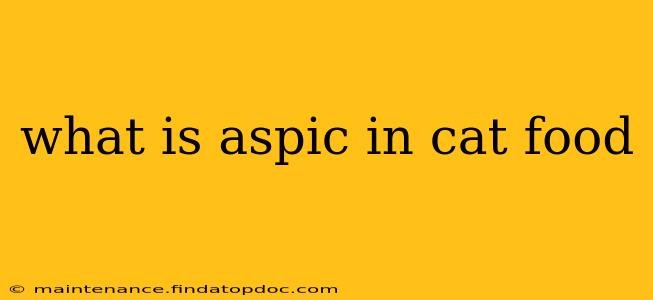Aspic in cat food refers to a gelatinous, jelly-like substance often used as a binding agent or a visually appealing component. It's derived from collagen, a naturally occurring protein found in animal connective tissues like skin, bones, and cartilage. While it might seem unusual, aspic's presence in some cat foods serves several purposes. Let's delve deeper into what aspic is, its benefits, and potential concerns.
What is Aspic Made Of?
Aspic in pet food is typically made by boiling down animal parts rich in collagen. This process extracts the collagen, which then sets into a gel upon cooling. The exact source of the collagen can vary depending on the manufacturer, but it's commonly sourced from beef, pork, or poultry. The resulting aspic is essentially a concentrated form of collagen, providing a smooth, jelly-like texture to the food.
Why is Aspic Used in Cat Food?
Several reasons explain why manufacturers incorporate aspic into certain cat food formulations:
-
Binding Agent: Aspic helps to bind the ingredients together, creating a more cohesive and palatable texture, especially in pate-style or mousse-like wet foods. This prevents the separation of ingredients and ensures a consistent eating experience for your feline companion.
-
Moisture Retention: Aspic contributes to the overall moisture content of the food, which is crucial for feline hydration. Cats often don't drink enough water, and moist food can help them stay adequately hydrated.
-
Palatability: The smooth, jelly-like texture of aspic can make the food more appealing to cats, particularly those with dental issues or those who are picky eaters. The addition of aspic can enhance the overall sensory experience of the food.
-
Visual Appeal: Aspic adds a visually appealing glossy sheen and texture to the food, making it look more attractive to both cats and their owners.
Is Aspic Safe for Cats?
Generally, aspic derived from reputable sources and produced under safe manufacturing conditions is considered safe for cats. However, potential concerns include:
-
Source of Collagen: The quality of the collagen source directly impacts the safety and nutritional value of the aspic. Always opt for cat foods from reputable brands that clearly list the source of their ingredients.
-
Allergies: Some cats may be allergic to specific protein sources used in aspic production. If you notice any adverse reactions after feeding your cat food containing aspic, consult your veterinarian.
-
Additives: While aspic itself is generally safe, some manufacturers may add other ingredients to the aspic base. Always check the ingredient list carefully to avoid potentially harmful additives or fillers.
How Can I Tell if My Cat Food Contains Aspic?
Check the ingredient list on the cat food packaging. Aspic may be listed under various names, including "gelatin," "hydrolyzed collagen," or simply "stock." If the food has a noticeably jelly-like texture, it's likely to contain aspic.
What are the alternatives to Aspic in Cat Food?
Many cat foods achieve a similar texture and moisture level without aspic. These alternatives often utilize different binding agents, such as guar gum or other natural thickening agents. You can find many high-quality cat foods that don't contain aspic.
Is Aspic Necessary in Cat Food?
No, aspic is not a necessary ingredient in cat food. Many excellent cat food options are available without it. The primary function of aspic—binding and moisture retention—can be achieved through other methods. The decision to choose a cat food containing aspic is a personal one based on your cat's preferences and your own priorities regarding ingredients.
By understanding what aspic is and its role in cat food, you can make informed decisions about the best diet for your feline friend. Remember to always read the ingredient list carefully and consult with your veterinarian if you have any questions or concerns about your cat's diet.
